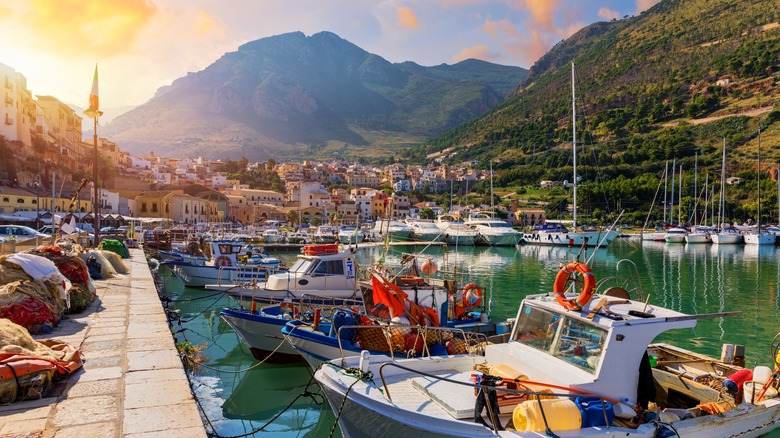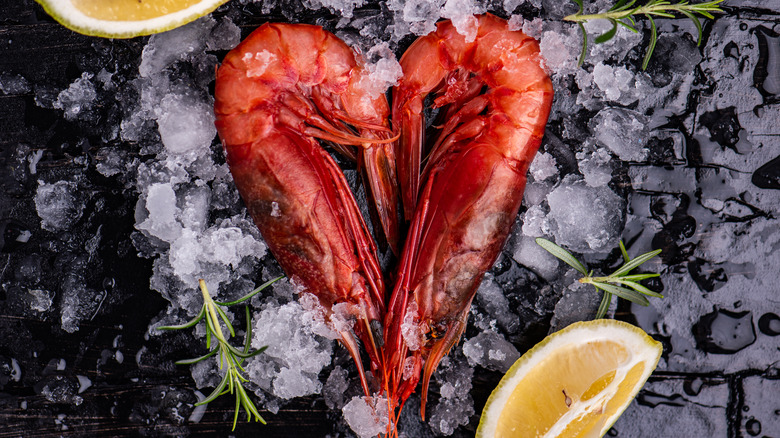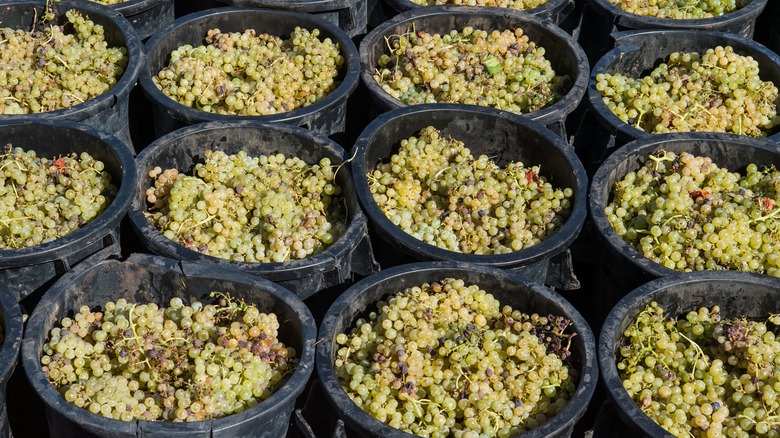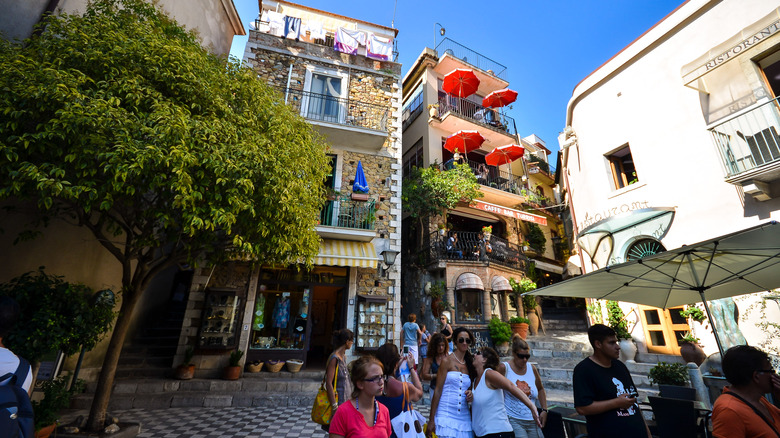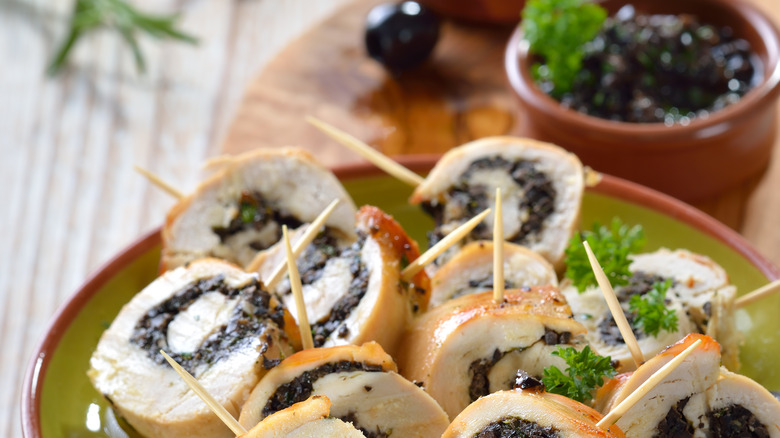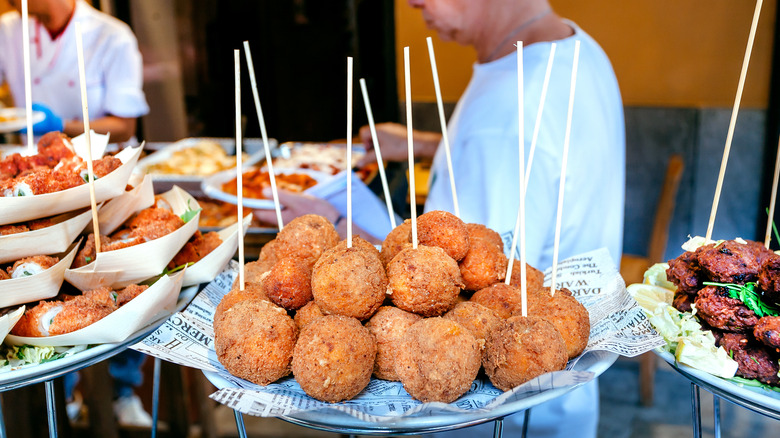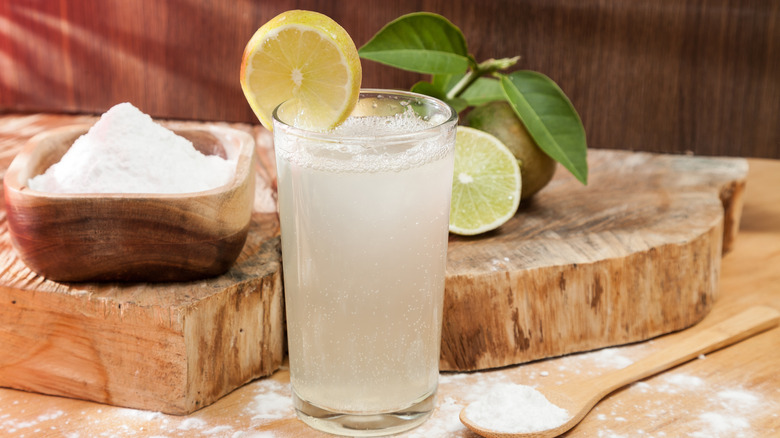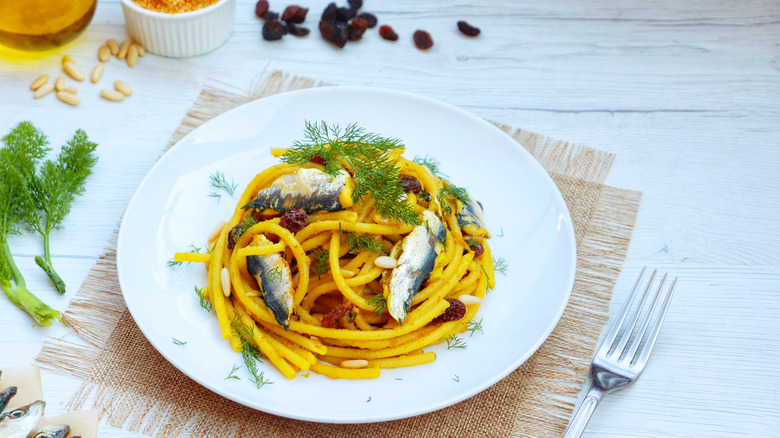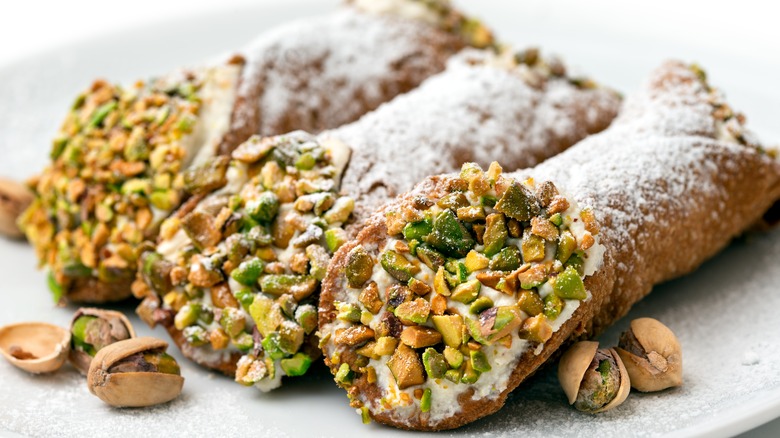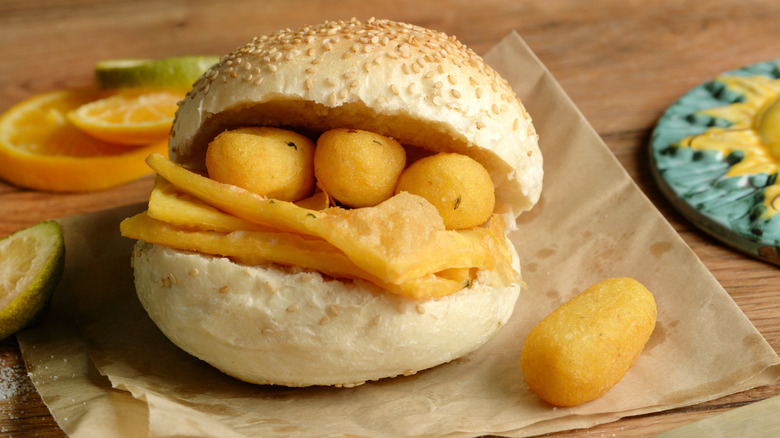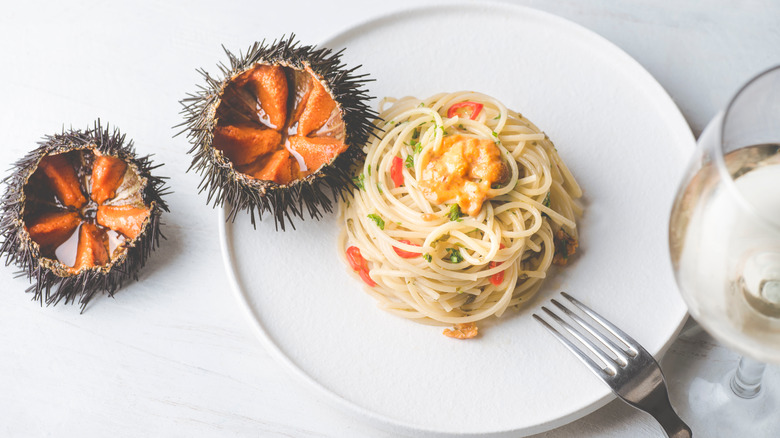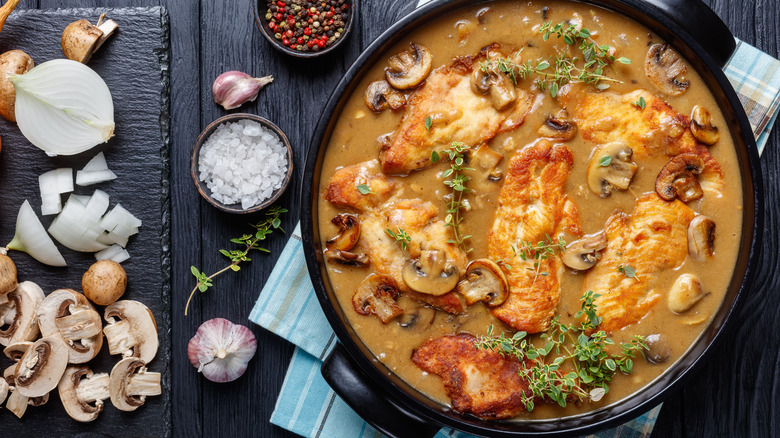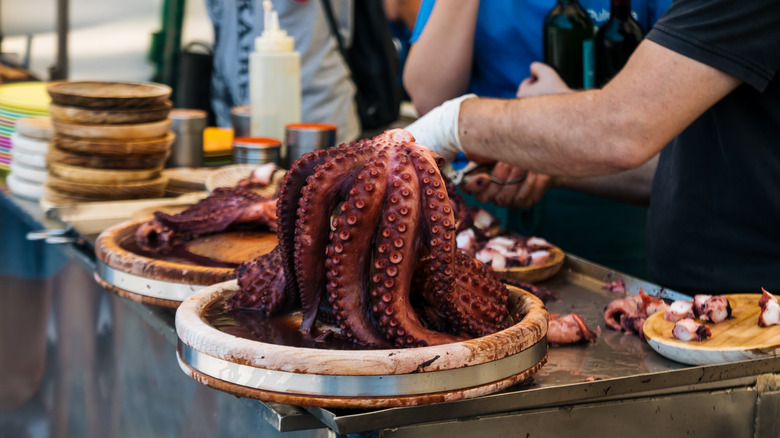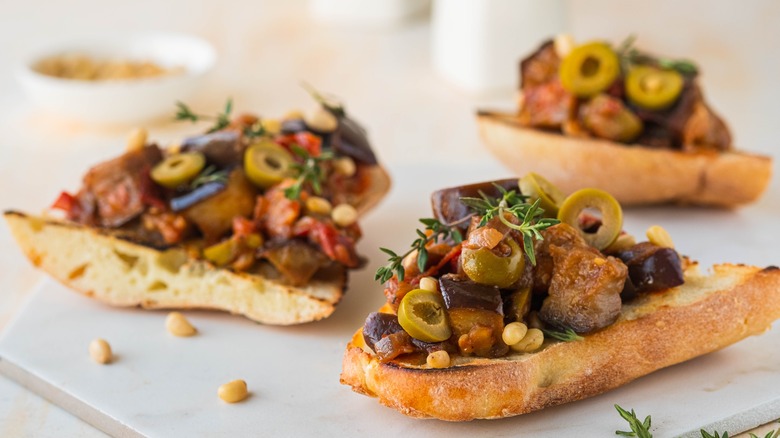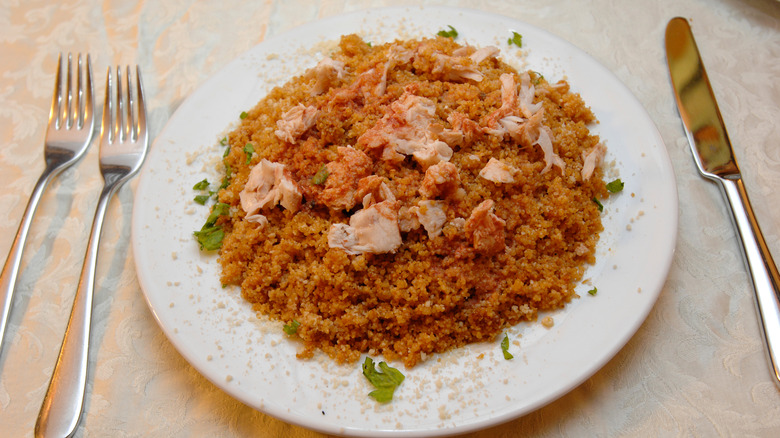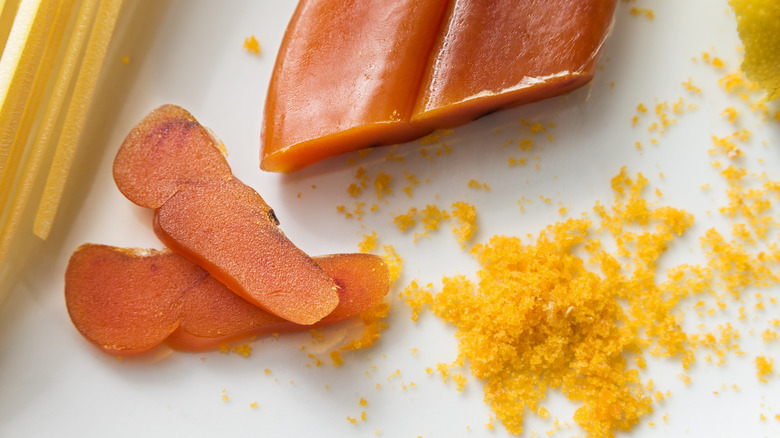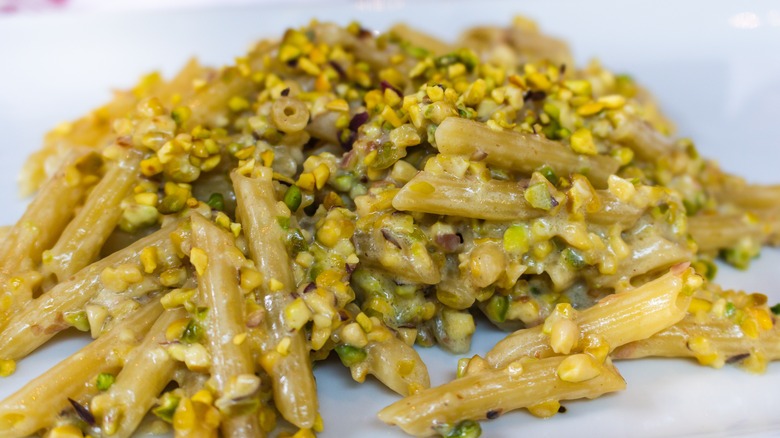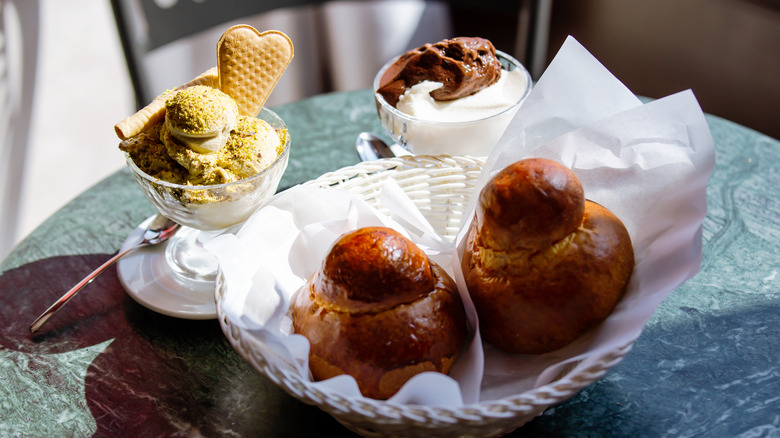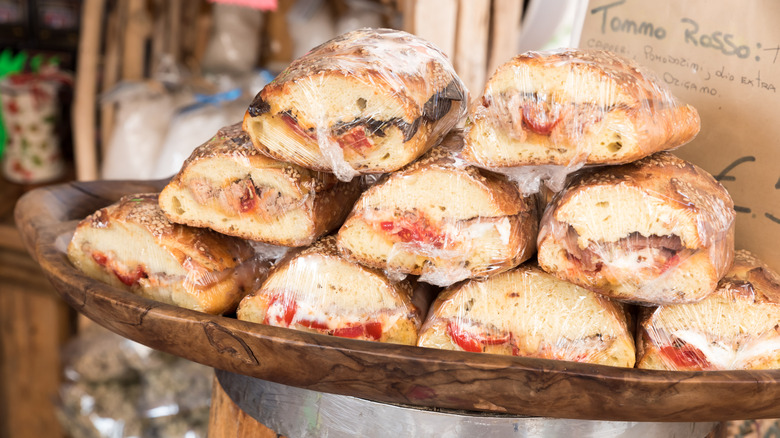18 Foods And Drinks You Have To Try In Sicily
Picture it — Sicily. Born out of volcanic action, the island's fertile soil, briny blue seas, and abundant sun offer produce and fish so fresh it tastes otherworldly. Olives, oranges, lemons, eggplants, prickly pear, artichokes, tomatoes, pistachios, capers, almonds, and grapes grow bountifully. The Mediterranean is plentiful with sea bass, swordfish, tuna, gold bream, clams, scabbard fish, squid, octopus, mussels, prawns, sardines, and anchovies. The salt is harvested locally from the sea, olive oil is freshly pressed, capers berries are plucked fresh from the bush, and ricotta salata is made regionally and aged to perfection. With all these ingredients at their disposal, Sicilians have long impressed the world with their culinary delights. The local wine production makes for a perfect accompaniment to the cuisine. Ranging from bold nero d' avola, light and crisp grillo, floral and delicate malvasia, unctuous passito, and nutty and layered Marsala, there is a wine for every dish.
Sicily has a long history of being ruled by different countries, and the culinary influence tells the tale of these periods. Ingredients and methods are a mix of Greek, Arabic, Spanish, and North African combined with native Sicilian goods.
Gambero Rosso
If you are served these bright red prawns, just know this is a special dish. Not only are they incredibly delicious and unlike any prawn you have ever tasted, but they are also incredibly dangerous to procure, making them the most expensive prawn in the world. These deeply-hued red prawns get their distinct color from volcanic mineral remains in this part of the Mediterranean, where they live at a depth of 700 meters. They are often served raw, with a drizzle of olive oil and locally harvested salt. They melt in your mouth and have a slight melon sweetness and an intriguing smokiness.
Sicilian fishermen have sourced this delicacy for eons in the south and west of Sicily towards North Africa. However, according to The Guardian, Libyan fishermen disagree on the boundaries Sicilians have been fishing and view it as a territorial invasion. As a result, Sicilian boats, and even fishermen, are confiscated by Libyans for a hefty return price, causing a considerable drop in gambero rosso access in Sicily.
Malvasia
Versatile, beautiful malvasia is a heady white wine with floral aromas and fresh peaches, tamarind, and citrus. It is grown mainly on the Aeolian Islands of Lipari and Salina off the Western coast of Sicily. It can be vinified dry, offering a crisp and light wine to enjoy any time of day, or made into two different sweet wines — "dolce naturale" or "malvasia Delle Lipari liquoroso." According to Wine Tourism, it is made by leaving residual sugar behind in the fermentation process, making it sweet and syrupy. Dolce naturale is even sweeter and has significant heft, as it is fortified with a neutral grape spirit to bump up the alcohol content. This wine's intense sweetness and unabashed flavors have landed it the nickname "Nectar of God."
A lovely dry Malvasia by Colosi, along with light pasta with fresh fish and vegetables, or a honeyed passito-style Malvasia by Hauner with fresh figs and ricotta over arugula will transport you to the island of Lipari.
Castelmola Almond Wine
Almonds are a massive part of Sicilian cuisine. Eaten raw or used in desserts, they find their way into many gastronomic creations — even wine. Komoosee tells us that 80% of the national almond production comes from Sicily and that the quality of almonds is superior. There are about 300 local varieties of almond trees in Sicily's City of the Temples, which hosts the Festival of Almond Blossom each year.
On the other side of Sicily, near medieval Taormina, Castelmola Almond Wine is made using a blend of local almonds and grapes. Served chilled with a slice of orange peel, it is a refreshing and intriguing beverage to sip while sitting at an outdoor café and taking in the sights. Some of the sights are... interesting. The most popular spot for this specialty is Bar Turrisi. It is known for its incredible panoramic views from the terrace and its plethora of phallic symbols inside the bar, earning it the nickname "Penis Bar." Not every day can you enjoy a glass of rare almond wine while surrounded by penises.
Involtini
Involtini are roulades made from thinly sliced meat stuffed with a vegetable or meat filling. The traditional stuffing for an involtini is a slice of prosciutto and sage leaves, and the outside casing is typically made with veal or beef. Since these can be made with whatever ingredients you have on hand, various styles run the gamut. Some versions use thin slices of chicken or fish or vegetarian versions with fried slices of eggplant for the outside. The filling can be any mixture desired, from anchovies, sun-dried tomatoes, smoked mozzarella, ham, speck, spinach, and arugula — you name it. Once you have filled your chosen casing, they are rolled and floured before cooking in a pan. Here is another option to choose your own involtini adventure — some are cooked simply in olive oil, or the option to add Marsala or cream comes into play.
These are popular dishes across much of Italy; however, involtini is serious business in Sicily, notes The New York Times. Involtini ammucca — ammucca, meaning "to devour," are veal rolls stuffed with fried eggplant in tomato sugo and grated caciocavallo cheese dipped in egg breadcrumbs and deep-fried until they are golden brown. In Palermo, a style often seen is beef or swordfish involtini stuffed with raisins, pine nuts, pecorino cheese, onion, and bread, grilled with pieces of red onion and fresh bay leaves.
Arancini
Crispy outside with a soft inside, arancini are a classic Sicilian dish consisting of balls of rice stuffed with various fillings and baked or fried to give the outside crunch. The rice is infused with saffron for color. The classic arancini are filled with meat ragu and peas, but Nonna Box tells us that many versions now exist. Their shape differentiates them — those with meat sauce remain round, and the arancini stuffed with mozzarella, cooked ham, and bechamel are oval. In Catania, home of Mt. Etna, the classic meat version has a conical shape as an homage to Etna. Beyond these two popular styles, there are many variants. In Catania, arancini alla norma features fried eggplant, tomato sauce, salted ricotta, and pistachios. Meanwhile, in Messina, Sicilian salmon is the star of arancini. Chefs worldwide have made their own riffs on the arancini, stuffing them with everything from curry to wasabi.
Arancini are crucial to the story of Sicilian cuisine and its Arabic history. that each year there is an Arancini Festival. It takes place on the day of Saint Lucia, during which bread and pasta are not consumed. According to Scent of Sicily, in 1646, Palermo was going through a terrible famine until December 13, when fishermen prayed for the intercession of Saint Lucia. A ship full of corn magically arrived at the port, saving people. Since then, no pasta or bread has been eaten on that day. The tradition of eating corn has morphed into the rice-based arancini.
Seltz
This refreshing drink is primarily found in the Catania area, near Etna. Seltz is pretty much upscale lemonade. It is made with three ingredients — Sicilian DOP Siracusa lemons, sea salt (local, of course), and sparkling water. According to Dissapore, it is sacrilege to call it sparkling water, as it is unique, volcanic mineral water that has been carbonated. To make this an adult lemonade, add some gin and bitters. Etneus Volcanic Gin and Etna Bitter are the perfect local products to add. To make seltz, squeeze a lemon into a glass, top it with a splash of sparkling water, stick a wet espresso spoon in sea salt and stir the lemonade — this will make a nice foam.
To garnish, add a strip of lemon zest. The electrolytes of sodium chloride integrate the seltzer and lemon, making the drink extremely thirst-quenching. Seltz is usually sold in kiosks around the city and typically has a variety of flavored syrups that can be added to your seltz.
Pasta Con le Sarde
When the sea is your backyard, most meals feature fresh catches. Sardines are a healthy and savory fish used in many Sicilian dishes. Pasta con le sarde is a dish made from fresh pasta in a sauce made from onions, raisins, pine nuts, anchovies, sardines, and saffron, then topped with toasted and seasoned bread crumbs. Another thing that makes this special is aneto, a wild dill that grows in Sicily. Fennel can be swapped out for aneto if cooking this yourself. The pasta type used is typically bucatini, but if it's not available, spaghetti will work. Because this dish uses so many regional delicacies, making it outside of Sicily introduces the need for many swaps.
Another swap to make this easier is that this can be made using tinned sardines. Like so many other regional dishes in Sicily, pasta con le sarde is of Arabic origin due to Islamic rule in the 10th century. While most ingredients are standard Italian products, pine nuts, raisins, and saffron are of Arabic influence.
Cannoli
Cannoli has proven itself on the world's culinary stage and can usually be found pretty easily outside Sicily. However, they can be quite different depending on how they are prepared. These scrumptious hard shells filled with sweet ricotta tend to be cloying when store-bought in The States, but cannoli in Sicily only have a hint of sweetness. Sicilian cannoli are made with sheep's milk ricotta because it is richer, and sometimes pieces of chocolate or Marsala wine are mixed into the filling. Some are then garnished with chopped pistachios or candied fruit.
The filling is added only at the very end so that the shell stays crispy. This recipe calls for orange zest and Madeira wine, and this one uses pizzelle for the crunchy exterior. No matter how you make them, cannoli is the perfect afternoon treat. Paired with a gorgeous passito di pantelleria wine, it becomes an epic delight.
Panelle
A vegan and gluten-free staple dish from Sicily? According to Italy Magazine, these chickpea fritters are just that. Typically found in friggitorie or fry shops in Palermo, panelle is a popular street food (cibo da strada) that is easy to grab and continue strolling. Panelle are crispy fried patties of chickpeas, salt, pepper, and parsley. A splash of lemon adds brightness to the rich dish. They are served on a sesame-seed sprinkled durum wheat roll, perfect for walking and noshing. When served in a sandwich, they are called pane e panelle. Some U.S. restaurants add tomato sauce, mozzarella, caciocavallo, and ricotta cheeses to their panelle.
Panelle is said to have originated during the period of Arab rule from the ninth to 11th centuries in Sicily. Initially, these were made for the lower class due to the inexpensive ingredients, Philos Kitchen tells us. The use of parsley and lemon mimics traditional fish dishes on the cheap. It was known as panella fish at the time. Now, panelle are enjoyed by people of all classes that love delicious food.
Pasta Coi Ricci
Pasta coi ricci is usually served as a first course. It is a creamy dish of linguine with sea urchin. Sea urchins are plucked fresh from the sea and cleaned before being added to the pasta, along with tomato, basil, garlic, parsley, and olive oil. The option to add red pepper for a touch of heat and lemon for a burst of freshness is up to you. MasterClass describes the taste of sea urchins to be sweet and salty with an abundance of umami from the amino acids they contain. They also have a lovely brininess from the seaweed they feed on and the ocean waters where they live. The unique and layered flavors are matched by their buttery, melt-in-your-mouth texture.
For such a decadent first course, cut through the richness with a glass of Donnafugata Brut. This Sicilian sparkling wine has bright and fresh acidity and a smooth perlage. An edge of minerality matches the brine of the pasta coi ricci effortlessly.
Chicken Marsala
Chicken Marsala is a classic dish, but is it classically Sicilian? There is much debate as to the dish's origin, but one thing is for sure — the star ingredient, Marsala fortified wine, hails from the Marsala region of Sicily. Wine Folly explains that Marsala wine can be dry or sweet and has very expressive notes ranging from apricot, toasted nuts, tamarind, Morello cherries, and even tobacco, depending on if it is gold, amber, or ruby Marsala.
Scraping up the browned bits from the pan with a dash of Marsala gives this dish its savory and distinctive taste. Chicken Marsala had an absolute chokehold over the culinary scene of the 70s and 80s, but it is still as delicious as ever. Marsala dishes can be made with chicken breasts, thighs, or veal (more classically Sicilian), pounded thin. Floured chicken is cooked in oil and then dredged in a sauce of mushrooms, butter, garlic, and of course, Marsala wine. Recipes will usually tell you to buy cheap Marsala cooking wine at the grocery store, but the real deal is much more flavorful (plus, you can drink what you don't use in the recipe). This recipe adds cream to give it even more richness. Obviously, the best pairing for this dish is a glass of Marsala. Cantine Florio is an easily accessible brand with a variety of Marsala styles.
Polpo Bollito
One of Palermo's most adored street food is polpo bollito, or boiled octopus. Along the stretch of beach called Piazza di Mondello, people can grab a colorful ceramic dish of the celebrated dish to eat at the standing counters. You'll know you are close by the salty-sweet smell of the boiling octopus and vendors yelling "u purpu cavuru" (hot polpo). The polpo is boiled until soft enough to melt in your mouth. Then, it is simply cut into pieces and seasoned with local olive oil, parsley, and lemon. For sit-down versions, it can be seen served as a salad with potatoes, in a ragu, or murato-style (simmered in tomato, herbs, and spices in a sealed earthenware).
La Cucina Italiano suggests a crisp glass of local inzolia — its striking minerality and heady floral aroma pair well with the sweetness of the polpo. A Catarratto bianco is another excellent choice, offering aromatics of lemon zest, wild oranges, grapefruit, and lavender, with a hint of baking spice.
Caponata
This is just Sicily showing off. Caponata features Sicily's best local goods all in one savory and briny dish. It is a vegetarian salad made with roasted or fried eggplant, onions, bell pepper, celery, and tomatoes with salty olives and sea-salted capers. It is hit with a kick of vinegar and sometimes topped with pine nuts. Some versions add a little sweetness with raisins or honey. It delivers an exquisite balance of sweet, salty, and sour. Some think of it as Sicily's version of ratatouille. Serve it with some crusty bread or as a topping for meat and fish dishes. Its flavor improves with age, and it will keep for a week in the fridge.
This recipe suggests making caponata crostinis. Once again, the Arabs are to thank for introducing the aubergine (eggplant) to Sicily. Caponata is not only a blend of taste sensations; it is a mash-up of culinary cultures.
Couscous
Another Arabic culinary influence is the importance of couscous in Sicilian cuisine. It goes by the name of cuscusu in the Sicilian dialect. The couscous here is serious business — none of the boxed stuff. Instead, these tender balls of durum are hand-rolled to perfection. Couscous alla trapanese is topped with seafood and served with intensely rich fish stock. The stock is complex because it involves 12 garlic cloves, two onions, celery, parsley, sliced almonds, fresh tomatoes, and red pepper flakes. The fish include sizeable head-on shrimp, mixed fish, and shellfish, such as red snapper, sea bass, calamari, and mussels. Lemon can be used as a garnish.
Couscous al nero di seppia is a variation featuring cuttlefish (and its ink) with shrimp and zucchini. Some white wine and basil add freshness to the dish. For gorgeous plating, the white cuttlefish and globs of ricotta sit on top of the deep black couscous.
Bottarga
Bottarga is one of the most profound ingredients that add umami to a dish. Bottarga is a salted and sun-dried tuna roe used to enhance a dish, much like a sprinkle of parmesan or a few slices of truffles. Mullet roe is sometimes used, but tuna (tonno) is more traditional. It is grated on top of many meals, just like hard cheese. Pasta, eggs, risotto, and salad are just a few of the meals bottarga can elevate. According to All Things Sicilian and More, the name bottarga is derived from the Arabic buarikh or butarah — raw fish eggs.
During Arabic rule in Sicily, it was made by dipping the egg sac in beeswax and leaving it to dry. These days the roe sac is covered with sea salt, dried for up to two months, and then hand-pressed into a solid mass. The Slow Food compendium called The Ark of Taste is interested in preserving these methods of production, notes All Things Sicilian and More.
Pasta al Pesto di Pistacchi
Pistachios are a considerable part of Sicilian gastronomy. Sicilian pistachios are grown and harvested on the island's east coast in the town of Bronte. Harvest occurs every two years in order to let the trees rest, which in turn produces pistachios of superior quality, via Strazzanti. Sicilian pistachios are called "pistacia vera," meaning "the true pistachio."
Used in tons of desserts, pistachios give a grassy and nutty note to temper sweetness. What's interesting is that pistachios are also used to make pesto. They replace pine nuts in a typical recipe, adding depth of flavor. A touch of mint to the usual ingredients of lemon zest, parmesan, garlic, olive oil, and basil adds a burst of freshness. Pistachio pesto is used in pasta dishes, on white ricotta pizza, and in arancini. This recipe by Chef Jeff Cerciello differs a little, using toasted pistachios, Meyer lemon, and red pepper flakes over a pasta dish with soft, boiled broccoli.
Granita
Across Sicily, visitors will find many open-air bars serving granita. The hot, Mediterranean climate makes this cooling dessert very popular. According to Visit Sicily, granita came to be from an ancient tradition during the Middle Ages. In the winter, people would gather snow on Mount Etna, the Peloritani, Iblei, or Nebrodi mountains, and store it in "neviere" (holes lined with stone or brick – you can see examples in Buccheri) and then enjoy it during the hot summer season on the shoreline. Originally, the grated snow was mixed with lemon juice or sweet fruit syrups, but today granita has become a creamier version using water, honey, and sugar. In addition, flavors from fresh ingredients are added, such as Bronte pistachios, bitter almonds, and lemon.
Granita is served all day long (even for breakfast) and is usually presented with a warm brioche bun. The brioche is meant to be dipped into the granita.
Pane Cunzato
If you saw "Bread of Misery" on a menu, you would probably order something else, but we urge you to try pane cunzato if given a chance. It is a showcase of Mediterranean goods on one plate. Pane cunzato used to be considered a poor man's meal (cucina povera), but today it is a popular apertivo and beach nosh. It started as a meal made from stale bread and whatever ingredients were on hand. Over time, pane cunzato evolved and can now be found all over the island.
A Sicilian Peasant's Table tells us that ingredients can include extra virgin olive oil, u capuliatu Sicilianu, which is a tapenade of minced sun-dried tomatoes marinated in olive oil, basil, and garlic, anchovies, pecorino or caciocavallo (sheep) cheese, tomatoes, and oregano on pane Siciliano (Sicilian sesame seed bread, usually a day old) or pane muffuletta. Olives and capers are also sometimes added for brininess.
